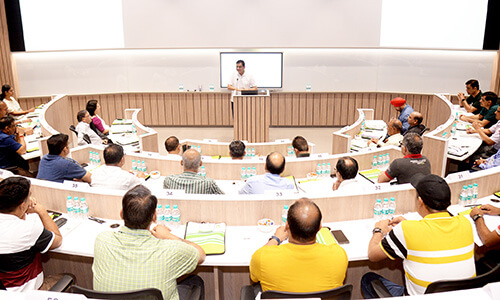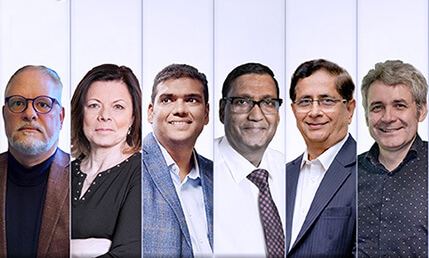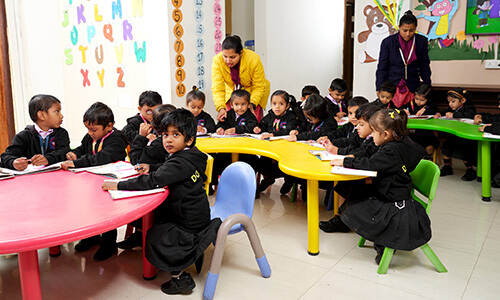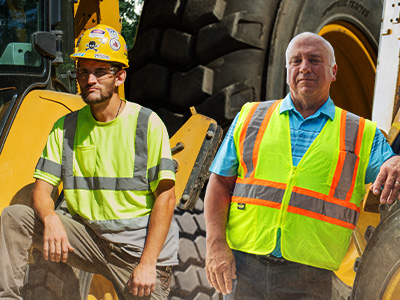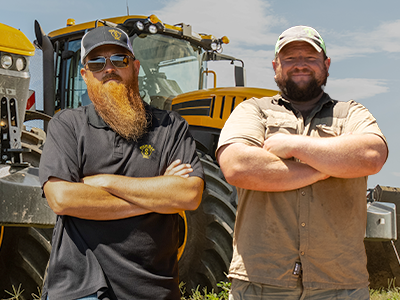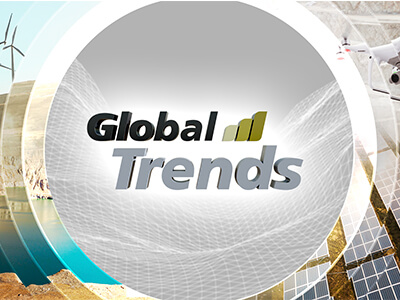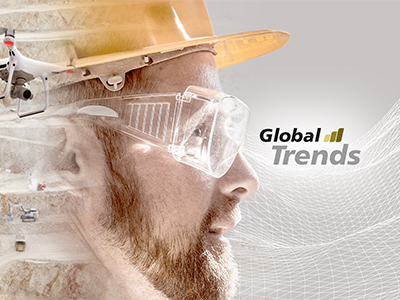Hello and welcome to Global Trends, the talk show covering your industry.
I'm Saana Azzam and I'm your host, helping you to delve deep into the trends that are making the headlines and driving forward developments across the industry.
Throughout the series, we're looking at what's happening today and what matters for tomorrow in the global OTR sector. Of course, I'm not doing this on my own. In each episode I shall be inviting into the studio some of the leading experts, the best and the brightest from across the industry and from around the world. Global Trends is here to deliver information, knowledge and understanding to inform and inspire you. We want you to treat Global Trends as a launchpad for your own curiosity.
At the end of the episode, look up our social media channels, join in the conversation, and see what everyone has to say. I hope we can whet your appetite enough that you can explore today's topic further for yourself.
And the subject we're exploring today, so far we've looked at technology, and still coming up are net zero and alternative energies. There's quite an overlap between all these topics, so, we're not by any means exploring them in isolation. And that's certainly the case for sustainability, today's focus. A term that's moved from relative obscurity into everyday usage in recent years, it's been applied to everything from food to transport to consumer goods.
But what does it really mean in practice? How can we address it? And crucially, can an industry like mining, which relies on extraction of finite mineral resources, ever truly be sustainable?
Those are some of the questions we'll try to answer during today's episode of Global Trends. Let's find out who's going to help me find those answers as we welcome the first of our guests to the studio today.
Mining Magazine since 1909 has provided those in the industry with in-depth technical insight into all the operational aspects of mining. It was founded by none other than Herbert Hoover, who would later become the 31st US President. Today, its editor in chief is Craig Guthrie. He leads an editorial team to provide industry coverage on critical midstream operations, technology, computing and more in the mining industry. Expert in journalism, social media, digital media and news writing, he is a communications professional with a specialised focus on digital channels.
Let's have him on stage. Craig, why don't you join me?
Craig, a very warm welcome to Global Trends.
I'm delighted to be here. Thanks for having me.
Wonderful, now it's a pleasure to have you, and as usual, though, before we get started with our guests, don't miss the chance to follow us, watch the episodes on our social media channels and share your reactions and opinions.
So, Craig, let's start. How would you say the magazine's purpose has changed over the last 114 years?
Well, in some ways it hasn't actually changed, lots of threads from the past still continuing today. For example, it's still a forum to share methods to improve productivity and efficiency across the industry. So, the subjects may have changed, but the way we look at them hasn't.
And is ESG a subject that's coming up?
Yes, it's increasingly an area of our coverage alongside other modern developments such as artificial intelligence and battery electric vehicles. We have a broad remit from mine design all the way to processing. It's a huge value change, a huge variety of disciplines and a really broad geographic area.
So with that in mind, I guess there's no typical reader for the magazine.
If I was to define an indicative group, it would be the C-suite. But the C-suite focused on the technology and operations side of things. which brings us neatly into ESG.
In many companies, the ESG officer is in that C-suite position. So, what's driven that?
So, what we've seen at a corporate level is that net zero goals have been set into the future, 2030, 2040 even 2050. So, our leadership is focused on actually operationalising those goals, achieving them on the ground. And that involves technology around that, it involves mine design, plant design, swapping out the fleet for electric fleets. The conversation is how to do this at a practical level and it won't be something achievable overnight. It's going to take decades to achieve that. So our big challenge is this is all occurring at the time that demand is spiralling for transition metals, so it's a double-edged sword.
Excellent, so, for all this talk of ESG, mining can be accused of greenwashing. So, can mining ever be described as sustainable, especially when we're using a finite resource?
Yes, that's the charge. For all the moves to renewable energies, wind, solar for example, we will need minerals. Recycling batteries will meet only a tiny percentage of the demand needed for that. We need to help the world move away from fossil fuels and towards minerals.
Those minerals, those transition metals, they're going to become the new oil and gas, I suppose.
Effectively, yes, but they'll be consumed in a very different way. They will be used and then recovered. They're not completely consumed like fossil fuels.
But will we reach a point where extraction decreases, all our existing metals will be infinitely recyclable?
Potentially, but only very far into the future. Most models expect global population to keep growing into 2080, 2090, and they will all need electricity and development to emerging populations. So, they'll need new materials.
Now let's give viewers an idea of how these policies are working out. What are some ESG examples you've seen?
Well, we're seeing a large process of digitalisation and automation taking across the industry. For example, big players are swapping out diesel trucks for battery electric trucks. We're also seeing the same process with automation of drilling rigs. For example, a controller in Finland could operate a drilling rig in Latin America for example, what we're aiming for is a fully autonomised, fully digitalised mine that's low footprint. For example, an underground mine where all the operations are under the surface and only a very small footprint above the surface.
And then in ESG, we have the letter S for social. So, can you talk to me more about that?
True, in certain jurisdictions, mining is an important employer. And if all the workforce was to be replaced with robots, that would have a major impact on that country's economy. So, there are also new standards coming into place playing an important role in societal impacts. And they are impacting on tailings, waste and end of life. But there are some good things around about how we can convert the waste into positives for the society.
So, can we?
Yes, for example, we've been working with a miner in Kazakhstan who's used the tailings from their mine and converted it into an aggregate that can be monetised for their local community. Another example is Vale, the Brazilian iron ore miner, is using sand from its operations in construction materials fulfilling an important need. So there are some important developments there, particularly around traceability.
Yes, so, let's talk about traceability. You mentioned standard bodies. They've put pressure, or they're a source of pressure on companies to comply with ESG obligations. Shareholders are another. Are we seeing any pressure from consumers yet?
I don't think that we have the same level of scrutiny yet, but some majors are preparing for it, and the EU is preparing legislation that will have more demand, more traceability in the supply chain. And for example, Rio Tinto has already introduced formative ideas, such as partnering with a blockchain company to trace the metals in an aluminium can from the mine all the way to the market. And it's not too long before consumers will get this and they'll demand more transparency.
Well, I believe that's a perfect segue for my next question. And what is the trend in consumer and corporate circles?
Well, like I alluded to at the start, it starts at that high level in pressure from investors. But it will still filter down to the public level. You don't see protests around mining to the same degree you see around oil and gas. If groups took a closer look at the industry, it could become a reality. There was an interesting example earlier this year where a London university barred its graduates from even talking to mining companies as a potential career. And that was a real shock to the mining community because we see ourselves as the solution, not the problem.
That is indeed an eye-opening anecdote that you shared with us. Now, you've drawn a distinction between oil and gas companies and mining. Why is that?
Well, we face the same issues in many ways. No matter how many resources the majors have available to them, they can't find quite the right message to get that across to the public. So if you go to an oil and gas or a mining conference, there's the same message going around. How can we alert or inform the public and particularly the younger generation about the importance of this industry in your daily lives? The difference is that we're here to stay for longer than oil and gas industry because we are needed for the transition.
Excellent, and, well, Craig, you're well placed to be able to help the industry deliver that. And I want to thank you for sharing your thoughts with me today, but don't leave quite yet because it's time for me to put you in the hot seat. We've asked our social media followers to submit questions to our guests, and I've picked this one for our Ask Away! segment. And the question is: if the industry wants to adopt and present a more sustainable face, what are three things it could do?
Well, it's a very big question, but I'll try my best. I think the first area I would look at is responsibility, the mining industry needs to see itself as a responsible stakeholder and that involves a new level of transparency into areas such as water use, land use that they're not really comfortable with at the moment. Another area I would identify is digitalisation and automation, really maximising the impact of and fully committing to it. Finally, there is a focus on people and communities that needs to be upped. They need to genuinely see what they're doing as important for the people in these communities and design that from the concept stage of mines all the way through to the end processing stage and another important area is brownfield sites need to have the same care and attention because most of the world's mines are existing and they need to be transformed.
Well, we ended on a good note, transformation. And I'd love to pick that up in more detail, Craig. But we should move on to our next guest, Craig Guthrie, editor in Chief of Mining Magazine. Thank you and join us again for our discussion in just a moment.
Well, Craig gave us a journalist's point of view in understanding the bigger picture. Now, we're going to hear from someone who's on the sharp end of helping companies deliver those sustainability plans that Craig just described.
We have Robert Pell, who's the founder and CEO of Minviro, a British consultancy that helps global companies in the raw materials sector to help assess, quantify and mitigate their impacts. Robert, please join me in the studio.
Robert, a warm welcome to Global Trends.
Thanks for having me.
So, now, your background is as a geologist, you've worked in the mining industry and the company you founded, I understand, is built around your PhD.
Yes, that's right.
So, we're focused on quantifying the environmental impacts of producing raw materials for the low carbon economy, considering the CO2 intensity, taking into account different equipment the energy involved in the processing plants etc.
And you help companies understand the impact of those processes?
Yes, we help quantify the impact, but we also navigate the impact reduction roadmaps and helping them identify the levers they can pull for their projects to get where they want to get in terms of sustainability.
Excellent, so it's a trend that Craig described, working with those C-suite teams to translate their sustainability words into actions. Clearly, you saw an opportunity to tap into that with the business. So, has it been vindicated?
Yes, absolutely. One of the key areas in which we've seen widespread adoption is with the materials that feed the low carbon transition, so things like lithium, nickel, cobalt. We've worked with over 170 commercial projects since our foundation in 2019. And this is across the mining and the metal, the refining sector, but we also work with consumers of those materials. So, one example is we worked with Tesla to look at the impact of their supply chain for their batteries.
So you're upstream and downstream?
Yes.
Excellent, now, concerning the upstream work, we've heard from other guests about this huge demand for these materials to support the energy transition. It appears to be a dichotomy that we have this opportunity for decarbonisation, but we need these minerals and metals to support that.
So, are we simply moving the problem elsewhere?
That's a really good question, and that's exactly what we try and solve when we're doing life cycle assessment, you're taking a holistic approach. For example, when we're working with a downstream battery manufacturer or an EV manufacturer, there's always the question of is electrification better than combustion engines? Now, we're looking at a full history of production and use and comparing those from an environmental standpoint, and not just for one impact category as well.
And what are some of those categories? Climate change is one, I presume?
Yes, so, climate change is maybe the poster child of impact categories. But when you think about extracting materials from the ground and processing, there could be impacts on land transformation, on freshwater depletion, think impacts on toxicity or even impacts on biodiversity.
Alright, and can you help us explain what's involved in the life cycle assessment? Why are companies so fixated on it?
Good question, so, in principle, what you're doing when you're conducting a life cycle assessment is you're collating an inventory of all the material and energy inputs as well as the emission outputs, whether that's to land, air or water, and you're translating those into environmental impacts that I mentioned before. Now, it matters in a number of ways for these, the companies that are doing these life cycle assessments. One, they want to do better. Companies do want to do better. But also there's an economic driver for this. There's risks for these companies if they don't understand their environmental impacts. And we've seen this in other sectors. For example, there's now stranded assets for coal mines that used to have high value but now don't have the value they used to. So by doing life cycle assessment, you can really get a deep understanding of where your environmental risks for your projects might be for the future.
Well, thank you for clarifying, beautiful. So, we talked to a guest in the last episode who gave the example of mines in Chile that are using desalination plants rather than extracting freshwater. They're relying on their own water just as other companies are focusing on harnessing renewable power for themselves. So, how do you incorporate factors like this in the life cycle assessment?
It's always an important process. When we're doing life cycle assessments for projects in the development stage or one that's already in operation, they're always looking at different situations like the desalination option that you mentioned versus just procuring freshwater. But this could also be the case for renewable energy at a site, whether they invest capital into a solar farm on site or whether they plug into the regional grid mix. So there's really lots of scenarios that they need to compare and we are able to basically highlight what the environmental potential of those different scenarios is, but also providing it in the economic context as well.
Wonderful, now, we've talked a lot about the upstream side of it, the companies extracting materials, they've got expectations from regulators and shareholders. But looking downstream, you've mentioned your work with Tesla. How much of that downstream side is the pressure from consumers now coming back up the chain and how do you believe it might pan out over the next few years?
We're certainly seeing more pressure coming from the downstream. I mentioned Tesla, but the battery ecosystem is quite a front runner in general. There are regulations that are evolving in the EU such as carbon footprinting requirements. You'll need to disclose the carbon intensity of your battery and there'll also be upper limits on what you can have in terms of carbon intensity of your battery, including the value chain, where it came from, and that will include where the lithium came from, where the nickel came from.
So there's really a great deal of pressure to understand the impact of the supply chains. And batteries are the leading technology, but we're seeing the same parameters and requirements for a range of other technologies as well.
So what are some of the other uses you're having to consider for clients?
Well, you'll see a trend. It's really the technologies that are for the low carbon transition. So, we've worked with photovoltaics in the wind sector, other parts of EVs. So, something that's close to my heart is electric motors and the rare earths that go into them. That's what I did my PhD on initially. But sometimes things like platinum group elements, which are going to be key for the hydrogen transition. But we really focus on understanding the impact of producing the raw materials, and that's because When you look at the low carbon transition, it really is sensitive to the raw materials that feed it. So, if we're going to really have an ultimate sustainable low carbon economy we'll make sure we need to produce these raw materials in a sustainable fashion.
Robert, you have given us an overview of your business, so, thank you so much. But before we go into the discussion, it's time to move to our Ask Away! segment. I'm going to put a question to you from our social media feeds. Let's try this one. Are you ready?
I'm ready.
Alright. So, how will this trend for LCA develop over the next 5 to 10 years? If I paraphrase that question, will your business need to change to cope with the demands for ESG assessments?
Well, it's a good question, fast evolving sector. So, we're both a technology and a consultancy. We have a technology part of the business because traditionally consultancy can take up to six months to deliver this life cycle assessment. Now, that's really not quick enough for what the industry demands today. So we've built tools that can help companies automate and fast track some of these processes. So if I was going to predict the future of the LCA market, there'll more technology, more data streams and more high-resolution reporting.
Thank you, Robert. Good luck with Minviro and come back to join us for the discussion in just a few moments. And there you have it, an overview of sustainability as it applies in the modern mining world. Now, let's go back to our guests for our studio discussion, Trends & Talks. Craig, Robert, let's have you back in the studio.
And we've got a third guest to introduce, too. Fabio Novelli, the founder, president and CEO of NTE Process, a technology and process consultancy that designs, builds integrated bulk material handling and process automation systems since 1998. After 25 years, he masters the business of industrial process solutions. Fabio, come and join me.
Warm welcome, Fabio.
Thank you.
And, gentlemen, it's lovely to have you back. I'm delighted that we all chose to match with a blue shirt for this topic, which is incredibly appropriate. Now, let's go to Fabio. You've been undoubtedly listening to Craig and Robert. Now is your chance to join in the discussion as we go into our wrap-up Trends & Talks.
What I'd like to hear from each of you is this: how can companies stick to their sustainability goals and succeed in keeping all their stakeholders happy?
Fabio, let's hear from you first, and I think you're particularly interesting since your company's been working with BKT to help them implement sustainable practises. Is that right?
Yes.
Yes, Saana, that's right. And this focus is design, implementation, innovation, industrial plants. BKT has set some clear sustainability goals and most big corporations are doing the same.
And they've been working with you on, I believe, a new tyre plant, is that right?
Yes, it's a tyre camber plant production in Bhuj in India which produces off highway tires. they focus on unsuitability objectives such as packaging reduction, CO2 reduction, energy reduction and reduction inputs from fossil fuels. For example, rather than moving raw material around the plant in polypropylene bulk bags, we have implemented the use of reusable mobile silos, the result of a lot of energy expended in moving those raw material around the plant. In the last five years, we developed a new patented technology to help with energy reduction. Overall, we looked for every opportunity to reduce not just energy but energy waste. We set up a goal of 70% reduction. Key for achieving this was a technology called Eco Dense Tronic. When implemented in Bhuj, this will save more than two million tonnes of CO2 emissions every year. We have got to remember that we need to be sustainable throughout the whole chain, in extraction and processing. So, it means that when companies choose the suppliers, they need to be sure that there is the same attention and focus on sustainability.
Excellent, a great start to our discussion, Fabio, thank you. Now, Robert, do you have any client examples you can draw on here?
Yes, we have many examples. One example is when we explored alternative energy solutions at a mining operation, specifically at a processing plant. If we look at batteries, we're currently exploring remanufacturing of batteries which would typically be used for EV applications, but then used for stationary storage. We're exploring the environmental impact benefits of such activity. Another example is we've more recently been working with some major alumina producers to measure their current environmental impact and simulate scenarios to deal with waste in different ways. Specifically looking at refractory waste products and seeing how they can be input in materials for other sectors such as the cement sector.
Well, with 170 projects completed, I knew you'd be able to come up with some great examples. Thank you, Robert. Now over to you, Craig, for the final word.
Well, I think one good example would be the increasing use of trolley assist systems to replace the use of diesel haul trucks. That's having a really big impact on emissions from operations. Now I wish we had time to open up this discussion in greater detail.
I feel that there's a lot more that the three of you could add. Thank you for joining us today on Global Trends and sharing your knowledge, experience with our audience.
Craig Guthrie of Mining Magazine, Robert Pell of Minviro and Fabio Novelli of NTE. It's been a pleasure talking to you today.
If you've watched the first episode, you'll remember it's time for another interactive session. This is Quiz You Up!, the segment where we invite you, dear viewers, to engage with us. Today, we're going to put the following question to you on social media and we want you to answer it. So, first, no doubt you'll want to know the answer to last month's question, where we asked you how much faster is it potentially to obtain data using drones to inspect mining sites rather than using traditional methods. And the answer is: 20x. The use of drones for mine surveys allows for more rapid data collection across the site, nearly over 20x faster than using traditional methods carried out by personnel on the ground. So, did you get it right? I saw that there's more than a few of you who did looking at those feeds, so, congratulations to you.
So who's going to go for two out of two? Let's see about this month's question. Both Craig and Robert talked about the importance of lithium as we transition into a low carbon energy economy. So, what I'm going to ask you for this episode's Quiz You Up! is: How much does the International Energy Agency predict lithium demand will grow by 2050?
A slightly more difficult question perhaps, but don't worry, we'll give you the answer next time.
So, there you have it. Global Trends, episode 2, Sustainability.
I hope you enjoyed it. Thank you for watching. We'll see you next time when our topic will be Alternative Energies.
